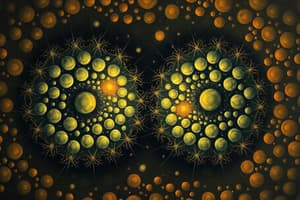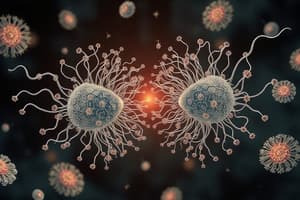Podcast
Questions and Answers
What is binary fission?
What is binary fission?
Asexual prokaryote reproduction; DNA replicates, cell gets longer, membrane closes in-between.
What is a septum?
What is a septum?
Separates the daughter organisms in binary fission.
What is binary fission?
What is binary fission?
Asexual prokaryote reproduction; DNA replicates, cell gets longer, membrane closes in-between.
What is a septum?
What is a septum?
What is binary fission?
What is binary fission?
What is the function of a septum in binary fission?
What is the function of a septum in binary fission?
Which eukaryotic cell cycle event is missing in binary fission? A) Cell growth B) DNA duplication C) Karyokinesis D) Cytokinesis
Which eukaryotic cell cycle event is missing in binary fission? A) Cell growth B) DNA duplication C) Karyokinesis D) Cytokinesis
FtsZ proteins direct the formation of a ______ that will eventually form the new cell walls of the daughter cells. A) Contractile ring B) Cell plate C) Cytoskeleton D) Septum
FtsZ proteins direct the formation of a ______ that will eventually form the new cell walls of the daughter cells. A) Contractile ring B) Cell plate C) Cytoskeleton D) Septum
Name the common components of eukaryotic cell division and binary fission.
Name the common components of eukaryotic cell division and binary fission.
How are duplicated bacterial chromosomes distributed into new daughter cells?
How are duplicated bacterial chromosomes distributed into new daughter cells?
How are chromosomes formed?
How are chromosomes formed?
What are histones?
What are histones?
What is chromatin?
What is chromatin?
What are homologous chromosomes?
What are homologous chromosomes?
What is a gene?
What is a gene?
What is a karyotype?
What is a karyotype?
What happens during the G1 phase of the cell cycle?
What happens during the G1 phase of the cell cycle?
What occurs during the S phase?
What occurs during the S phase?
What occurs during the G2 phase?
What occurs during the G2 phase?
What is the M phase?
What is the M phase?
List the stages of mitosis in order.
List the stages of mitosis in order.
What occurs during interphase?
What occurs during interphase?
What happens during prophase?
What happens during prophase?
What occurs during metaphase?
What occurs during metaphase?
What happens during anaphase?
What happens during anaphase?
What occurs during telophase?
What occurs during telophase?
What are the differences between animal and plant cells during mitosis?
What are the differences between animal and plant cells during mitosis?
What is the G0 phase?
What is the G0 phase?
What do cell cycle checkpoints check for?
What do cell cycle checkpoints check for?
What is cyclin?
What is cyclin?
What are proto-oncogenes?
What are proto-oncogenes?
What are oncogenes?
What are oncogenes?
What are tumor suppressor genes?
What are tumor suppressor genes?
Flashcards are hidden until you start studying
Study Notes
Cell Reproduction Overview
- Binary fission is an asexual reproductive process in prokaryotes involving DNA replication and cell elongation before membrane closure.
- A septum is a dividing wall that separates daughter organisms in binary fission.
- Karyokinesis, the division of a cell nucleus during mitosis, is absent in binary fission, as prokaryotes lack a nucleus.
Eukaryotic Cell Division Components
- Common components shared between eukaryotic cell division and binary fission: DNA duplication, chromosome segregation, cytoplasmic division.
- Duplicated bacterial chromosomes attach to the cell membrane for distribution into new daughter cells.
- Chromosomes form through tightly packed DNA, often wrapped around histones, which are proteins that help condense DNA into chromatin.
Chromosomes and Genes
- Homologous chromosomes consist of matched pairs that carry genetic information.
- Genes are hereditary units determining specific traits passed from parents to offspring.
- A karyotype is a visual representation of chromosomes arranged by length.
Phases of the Cell Cycle
- G1 phase involves accumulation of DNA, energy, and proteins, preparing the cell for division.
- S phase is dedicated to DNA replication.
- G2 phase focuses on energy replenishment, protein synthesis, organelle duplication, and cytoskeleton dismantling.
- M phase is when actual cell division occurs, encompassing mitosis.
Mitosis Stages
- Interphase serves as a preparatory phase for mitosis, where cells grow and replicate DNA.
- Prophase is the first and longest phase where chromosomes become visible and centrioles migrate to poles.
- Metaphase sees chromosomes align at the cell's equator, connecting to spindle fibers.
- Anaphase involves sister chromatids separating into individual chromosomes and moving apart.
- Telophase marks the end of mitosis with chromosomes gathering at opposite poles, forming two nuclear membranes.
Differences in Plant and Animal Cell Mitosis
- In plant cells, a cell plate forms during division.
- Animal cells utilize centrosomes during mitosis.
Cell Cycle Regulation
- G0 phase is for cells that do not frequently divide.
- Checkpoints in the cell cycle monitor:
- G1 for cell size and nutrient availability.
- G2 for DNA replication and cell size.
- Spindle Assembly for chromosome-fibre attachment.
- Cyclins regulate the timing of transitions between cell cycle phases.
- Proto-oncogenes code for proteins that promote cell growth, while oncogenes can cause cancer.
- Tumor suppressor genes prevent uncontrolled cell division by counteracting oncogene effects.
Studying That Suits You
Use AI to generate personalized quizzes and flashcards to suit your learning preferences.




